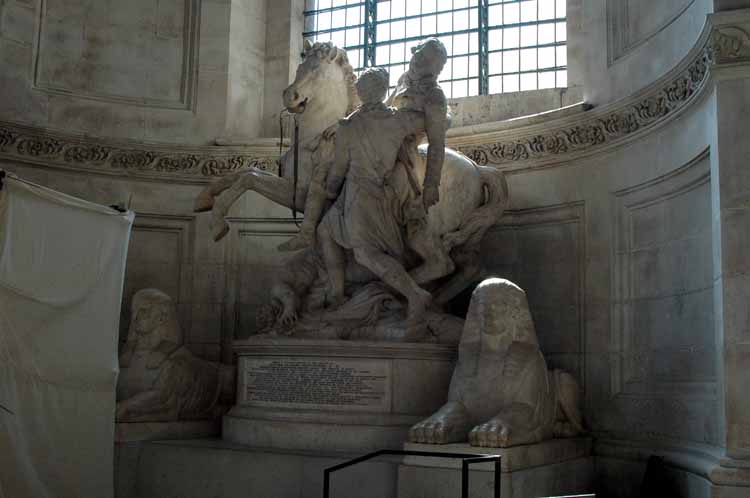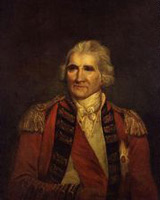 Sir Ralph Abercromby
Sir Ralph Abercromby
Inside St Paul's Cathedral is a memorial to Lt General Sir Ralph Abercromby KB.
Sir
Ralph Abercromby (sometimes spelled Abercrombie) (1734-1801), was a British
lieutenant-general and was the eldest son of George Abercromby of Tillibody,
Clackmannanshire, and was born in October 1734. The painting, which is in
the National Portrait Gallery in London was painted by John Hoppner (1758-1810).
He was educated at Rugby and Edinburgh University, in 1754 he was sent to Leipzig to
study civil law, with a view to his proceeding to the Scottish bar. On returning
from the continent he expressed a strong preference for the military profession,
and a cornet's commission was accordingly purchased for him, March 1756, in the
3rd Dragoon Guards. He served with his regiment in the Seven Years' War, and the
opportunity was afforded him of studying the methods of Frederick the Great
moulded his military character and formed his tactical ideas. He rose through
the intermediate grades to the rank of lieutenant-colonel of the regiment (1773)
and brevet colonel in 1780, and in 1781 he became colonel of the King's Irish
infantry. When that regiment was disbanded in 1783 he retired on half-pay.
That up to this time he had scarcely been engaged in active service was owing
mainly to his disapproval of the policy of the government, and especially to his
sympathies with the American colonists in their struggles for independence; and
his retirement is no doubt to be ascribed to similar feelings. On leaving the
army he for a time took up political life as member of Parliament for
Clackmannanshire. This, however, proved uncongenial, and, retiring in favour of
his brother, he settled at Edinburgh and devoted himself to the education of his
children.
When France declared war against England in 1793, he hastened to resume his
professional duties; and, being esteemed one of the ablest and most intrepid
officers in the whole British forces, he was appointed to the command of a
brigade under the Duke of York, for service in the Netherlands. He commanded the
advanced guard in the action at Le Cateau, and was wounded at Nijmegen. He was
tasked with protecting the British army in its disastrous retreat out of
Holland, in the winter of 1794-1795. In 1795, he received the honour of a
knighthood of the Bath, in acknowledgment of his services.
The same year he was appointed to succeed Sir Charles Grey, as
commander-in-chief of the British forces in the West Indies. In 1796, Grenada
was suddenly attacked and taken by a detachment of the army under his orders.
Abercromby afterwards obtained possession of the settlements of Demerara and
Essequibo, in South America, and of the islands of Saint Lucia, Saint Vincent
and Trinidad. He returned in 1797 to Europe, and, in reward for his important
services, was appointed colonel of the regiment of Scots Greys, entrusted with
the governments of the Isle of Wight, Fort-George and Fort-Augustus, and raised
to the rank of lieutenant-general.
 He held, in 1797-1798, the chief command of the forces in Ireland. There he
laboured to maintain the discipline of the army, to suppress the rising
rebellion, and to protect the people from military oppression, with a care
worthy alike of a great general and an enlightened and beneficent statesman.
When he was appointed to the command in Ireland, an invasion of that country by
the French was confidently anticipated by the English government. He used his
utmost efforts to restore the discipline of an army that was utterly
disorganized; and, as a first step, he anxiously endeavoured to protect the
people by re-establishing the supremacy of the civil power, and not allowing the
military to be called out, except when it was indispensably necessary for the
enforcement of the law and the maintenance of order.
He held, in 1797-1798, the chief command of the forces in Ireland. There he
laboured to maintain the discipline of the army, to suppress the rising
rebellion, and to protect the people from military oppression, with a care
worthy alike of a great general and an enlightened and beneficent statesman.
When he was appointed to the command in Ireland, an invasion of that country by
the French was confidently anticipated by the English government. He used his
utmost efforts to restore the discipline of an army that was utterly
disorganized; and, as a first step, he anxiously endeavoured to protect the
people by re-establishing the supremacy of the civil power, and not allowing the
military to be called out, except when it was indispensably necessary for the
enforcement of the law and the maintenance of order.
In a famous order of February 1798 he
described the army as being 'in a state of licentiousness which must render it
formidable to anyone but the enemy'. His comments caused a political storm.
Finding that he received no adequate support from the head of the Irish
government, and that all his efforts were opposed and thwarted by those who
presided in the councils of Ireland, he resigned the command. His departure from
Ireland was deeply regretted by the Irish people, and was
speedily followed by the disastrous results which he had anticipated, and
which he had been so keen to prevent.
After holding for a short period the office of commander-in-chief in Scotland,
Sir Ralph, when the enterprise against the Dutch Batavian Republic was resolved
upon in 1799, was again called to command under the Duke of York. The campaign
of 1799 ended in disaster, but friend and foe alike confessed that the most
decisive victory could not have more conspicuously proved the talents of this
distinguished officer.
In 1801, he was sent with an army to
dispossess the French of Egypt. His experience in the Netherlands and the West
Indies particularly fitted him for this new command, as was proved by his
carrying his army in health, in spirits and with the requisite supplies, in
spite of very great difficulties, to the destined scene of action. The
debarkation of the troops at Abukir, in the face of strenuous opposition, is
justly ranked among the most daring and brilliant exploits of the English army.
A battle in the neighbourhood of Alexandria (March 21, 1801) was the sequel of
this successful landing, and it was Abercromby's fate to fall in the moment of
victory. He was struck by a spent ball, which could not be extracted, and died 7
days after the battle. His old friend and commander the Duke of York paid a just
tribute to the great soldier's memory in general orders: "His steady observance
of discipline, his ever-watchful attention to the health and wants of his
troops, the persevering and unconquerable spirit which marked his military
career, the splendour of his actions in the field and the heroism of his death,
are worthy the imitation of all who desire, like him, a life of heroism and a
death of glory."
By a vote of the House of Commons, a monument was erected in his honour in St Paul's cathedral. His widow was created Baroness Abercromby of Tullibody and Aboukir Bay, and a pension of £2,000 a year was settled on her and her two successors.